KRZYŻTOPÓR CASTLE IN UJAZD
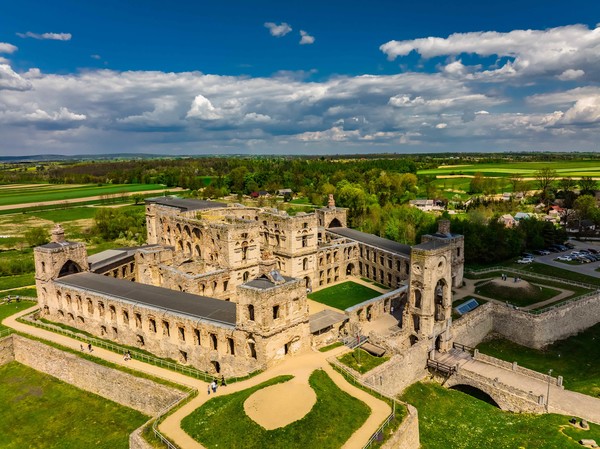
[아츠앤컬쳐] 크시슈토푸르 성은 유럽에서 가장 인상적인 건물 중 하나다. 건축에 활용된 건축학적∙기술적 방법들은 매우 경이로우며 폴란드 국내 수준을 넘어 유럽에서도 창의적이라 할 수 있다. 크시슈토푸르 성의 이름은 십자가(Krzy)와 도끼(Topor), 두 단어가 합쳐진 것이다.
산도미에슈 주의 주지사이자 ‘포테차의 팔라초’(요새의 궁전)의 설립자였던 크시슈토프 오솔린스키는 사람들에게 깊은 인상을 줄 수 있는, 크기와 화려함에서 비교불가한 거주지를 짓고 싶어했다. 따라서 1621년부터 1644년까지, 총 23년간 이탈리아 건축가 로렌스 세네스의 도움을 받아 달력에서 영감을 받은 기념비적인 궁전을 세웠다.

성에는 1년의 ‘일 수’만큼 많은 창문과 ‘주 수’만큼의 챔버실, ‘월 수’만큼의 방이 있었고, 한 해의 ‘계절 수’만큼의 탑이 있었다. 또한 건물의 세 개의 층은 화려하게 장식되었으며 대리석, 크리스탈 및 귀중한 장식품이 많이 사용되었다. 팔각형 탑의 천장은 유리로 만들어졌으며 이국적인 물고기가 있는 수족관도 있었다. 마굿간에는 대리석 여물통을 놓고, 수정 거울을 설치하는 등 호화로운 환경에서 말을 사육하였다.

성 안뜰로 이어지는 입구의 문에는 이 건물의 이름을 뜻하는 두 개의 상징물인, 십자가와 도끼가 얕게 새겨져 있다. 십자가는 창립자의 종교적 신념을 상징하고, 도끼는 오솔린스키 가문의 문장을 상징한다. 그 아래에는 ‘W’가 새겨져 있는데, 아람어로 영원을 뜻한다. 하지만 아이러니하게도 크시슈토프 오솔린스키는 공사가 완료된 지 1년만에 세상을 떠났다.
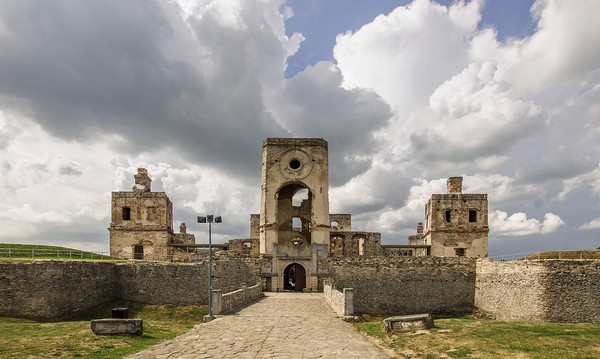
1655년에 ‘대홍수’라 불리던 기간 동안 스웨덴 군대가 이곳을 점령했으며, 군대는 성에 있던 모든 귀중품과 장비들을 약탈해갔다. 이로써 짧고 영광스러웠던 이곳의 시간은 끝을 맺게 되었다. 후에 이 성을 소유했던 이들은 이전의 화려한 모습을 복원시키지 못했으며 천천히 쇠락해 갔다. 1770년 바르 연합 당시에 러시아인들이 나머지 목재들마저 불태워버렸고, 이로 인해 크시슈토푸르는 구 폴란드 시대 영토에서 가장 큰 폐허가 되고 말았다.

현재는 폴란드 문화원이 성의 시설을 낙후되지 않게 관리하고 있으며 관광 시즌에는 이 지역의 역사를 홍보하기 위해 많은 행사가 개최된다.
400년 전 처음 지어진 이래로 크시슈토푸르 성은 그 광활함과 아름다움으로 전 세계에 깊은 인상을 남겼다. 성 복도를 걷다 보면 영광의 시절을 쉽게 상상할 수 있다. 수세기 전과 동일하게 폴란드의 고귀한 환대의 원칙으로 성의 문은 관광객들에게 활짝 열려 있다.
번역 | 김초은 주한폴란드대사관 문화 공공외교팀
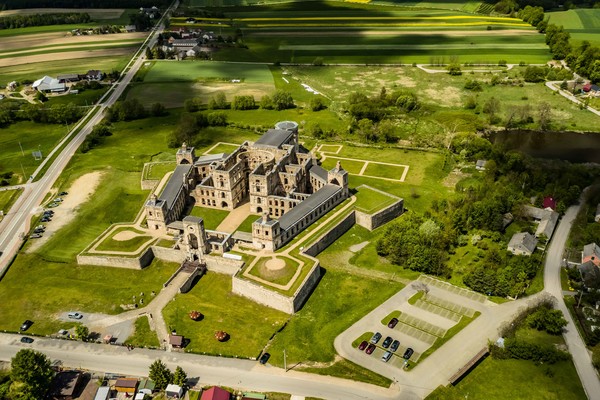
KRZYŻTOPÓR CASTLE IN UJAZD
Krzyżtopór Castle is considered one of the most impressive buildings in Europe. It is a marvel of architectural and engineering solutions used in its construction, unique on the national and even European scale. The name of the castle in Ujazd is a combination of two words: a cross (Krzyz) and an axe (Topor).

Krzysztof Ossoliński, the voivode of Sandomierz and a founder of the “palazzo in fortezza” – a palace in the fortress – wanted to impress his contemporaries and build a residence that would surpass all others in its size and splendor. In 23 years (1621-1644), with the help of Italian architect Laurence Senes, he erected the monumental complex of palaces built in a pentagon bastion fortress modeled on a calendar. The castle had as many windows as there are days in a year, as many chambers as there are weeks, as many rooms as there are months and as many towers as there are seasons of the year. Three stories of the palace were lavishly decorated, sparing no expense on marble, crystals and precious ornaments. The ceiling in the octagonal tower was supposedly made of glass and had a view of an aquarium with exotic fish. Even horses in stables were kept in a luxurious environment, as they had marble troughs and looked at themselves in crystal mirrors.
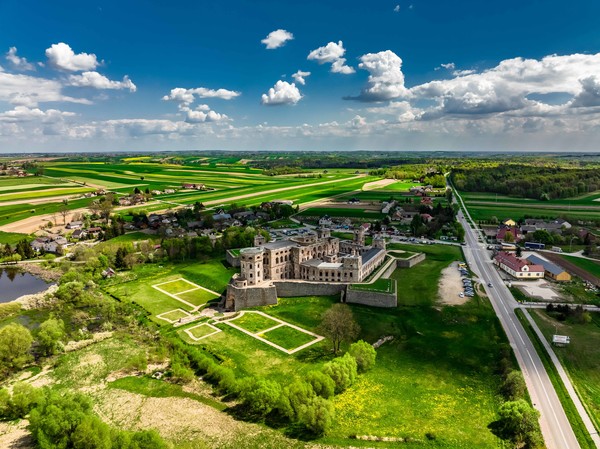
The main decoration of the entrance gate leading to the castle courtyard are two massive bas-reliefs, from which the name of the residence comes: the cross, symbolizing religious beliefs of the founder, and an ax, the family coat of arms of the Ossoliński family. Below Krzysztof placed the letter “W”, the Aramaic symbol of eternity, as a blessing.
Ironically, Krzysztof Ossoliński passed away only one year after the construction was completed.
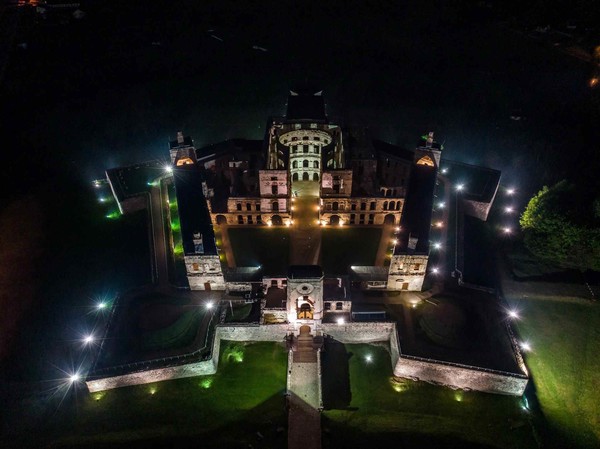
In 1655, the castle was occupied by the Swedish army during the “Deluge”, during which the army stripped the castle of all of valuables and pieces of equipment. Which would bring the short period of the magnificence of the residence to an end. No subsequent owner was able to restore the splendor of the castle and Krzyżtopór slowly fell into ruin. During the Bar Confederation in 1770, the Russians burned the remaining wooden elements, making Krzyżtopór the largest ruin in the territory of the Old Polish period.
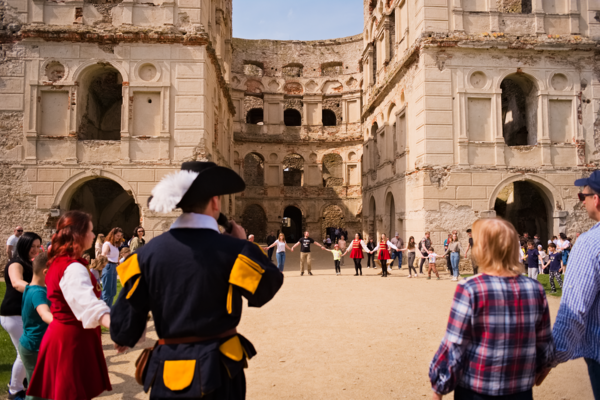
The Cultural Institution was appointed to take care of the facility to make sure that the castle does not fall into obscurity. During the tourist season, many events are organized to promote the region and its history.
From its inception 400 years ago to today, Krzyżtopór Castle continues to impress the world with its vastness and beauty. Walking through its corridors, it is easy to imagine the glory it once possessed. Just like centuries ago, according to the rules of noble hospitality, the gates of the castle are wide open to visitors.
Embassy of Poland in Korea 주한폴란드대사관 제공

